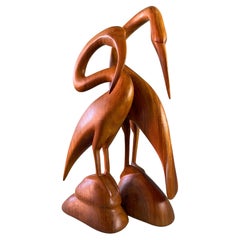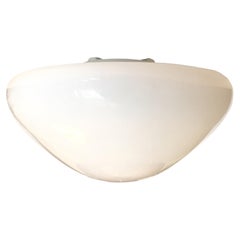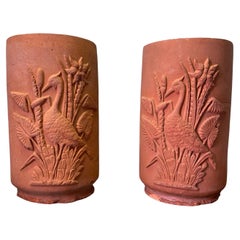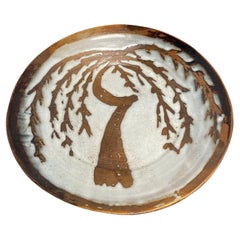About Cabinet de Luxe
Cabinet de Luxe offers a broad selection of 20th Century lighting, furniture, art and objects - always with an eye to combining beauty and utilitarian comfort. We specialise in meticulously cleaned, tested and certified vintage lighting, ready to hang or use, straight out of the box. Our furniture is sound, beautifully clean and in original vintage condition, though we may sensitively restore if necessary. Emma, who runs the show, also has an interest in promoting the lesser-known wonders of Australian 20th Century design. New stock is listed weekly, so do follow our s...Read More
Featured Pieces
Pair Large Hand Carved Teak Herons, 1960s
Located in Melbourne, AU
A pair of hand carved teak Heron, dating to the late 1960s, perhaps early 1970s.
There are no makers marks, signatures or labels. Balinese or Sumatran, in...
Category
Vintage 1960s Balinese Mid-Century Modern Animal Sculptures
Materials
Teak
Bauhaus Wagenfeld Wall Sconce or Ceiling Light, Germany, 1955
By Wilhelm Wagenfeld
Located in Melbourne, AU
This simple, elegant ceiling light or wall sconce by Wilhelm Wagenfeld shows the strong influence of his Bauhaus education. As with all of his designs, high quality, high functionali...
Category
Vintage 1950s German Bauhaus Flush Mount
Materials
Porcelain, Milk Glass
Pair Rare John Campbell Terracotta Chinoiserie Planters or Umbrella Stands
Located in Melbourne, AU
An exceptionally rare pair of John Campbell planter pots. The design is attributed to John Cambell's son, Rupert John Campbell.
John Campbell produced decorative pots at his brick works and pottery in Launceston, Tasmania from 1880 until 1975. Rupert John inherited his father's works and was a skilled artisan and potter. He developed presses for decorative pottery.
This beautiful pair of jardinières likely date to the early 1900s. They were passed down through three generations. The original owner gave them to her son. In the 1980s the (then elderly) son gifted them to a friend (the last owner before this sale). At the time they received them they were made aware of their age and rarity. Now, another forty years later, they are potentially the only pair in existence.
Only one similar John Campbell un-glazed terracotta 'umbrella stand' can be found on record. It was sold in 2008 in Tasmania, at a 'Fine Colonial Decorative Arts' auction run by Mossgreen Auctions, a reputable auction house, though since closed. I can find no other reference to this model, except an acknowledgement of the existence of an un-glazed terracotta umbrella stand, in the definitive record of Campbell's work by Kevin Power, 'John Campbell Pottery: Recollections and Collections' published 2014.
These are of the same design and size but were manufactured with drainage holes in the base. They were clearly decorated using a press but the clay slabs were pushed into the press by hand. The interior of each pot shows the marks of hammers used to force the clay into the face of the press pattern. They have a hand-crafted appearance, with hand finished mould lines to each side and there are pressing faults apparent in various areas of the pattern.
Tasmania was notably independent in production of most household goods, due to the isolation of the colony right up until the turn of the 19th century. Being at the farthest reaches of the British Empire, settled as a penal colony, with a relatively low consumer population, it was not a market for the high-volume import of domestic goods.
As a consequence, household wares and decorative pieces produced in Tasmania through the 19th century represent a wholly independent category of Australian colonial design, production and craft. These pots are highly collectable and scarce artifacts of one of Tasmania’s earliest industries.
In aesthetic terms, many Tasmanian artifacts are notable for following British, Georgian and Victorian fashions but with a colonial character of their own devising. Local characteristics became a stronger feature of Tasmanian decoration over time. Note the classical Georgian/Victorian chinoiserie motif of a bird foraging among rushes. In this case, the local interpretation depicts a Brolga (the largest Australian wetland bird) foraging amongst native Australian reeds and water lilies.
Another of the things that sets early Tasmanian artifacts apart is the way in which necessity forced artistic production in pottery to be less refined than that of their British counterparts. A broad range of products had to be produced to meet local requirements, often by a single producer.
John Campbell’s pottery is a great example of this practical necessity. It produced everything from industrial drainage pipes and bricks to household pottery and decorative items, all from a relatively small family run factory. Their domestic wares were so well trusted and appreciated that they by the 1940s they made their way all over the mainland of Australia.
Under these circumstances, the refinement of decorative technique was not as great a priority as utility, consistent quality of production and durability. As a consequence, Australian colonial works and their early 20th century descendants such as these pots, are hugely appealing. They have an idiosyncratic and vernacular appearance, with British and European stylistic trends of their day overlaying a base of inventiveness, local interpretation and sturdy functionality.
We hope you can appreciate the rarity and significance of this well-preserved pair of planter...
Category
Vintage 1930s Australian Chinoiserie Planters, Cachepots and Jardinières
Materials
Terracotta
Large Earthenware Studio Pottery Willow Plate or Bowl After David Leach 1970s
By David Leach
Located in Melbourne, AU
A very attractive bowl, plate or platter, dating to the 1970s. It has all the elements of a David Leach work - the willow motif, high quality earthenware, decorated using the wax res...
Category
Vintage 1970s Unknown Organic Modern Decorative Bowls
Materials
Earthenware
Brutalist Earthenware Slab Wall Hanging Sculpture 1970s After Peter Voulkos
By Peter Voulkos
Located in Melbourne, AU
A total commitment to experimentation with materials. This piece is unsigned, but we note the muscular slab-built Brutalism of this piece and wonder about the influence of American Brutalist sculptor...
Category
Vintage 1970s Australian Brutalist Wall-mounted Sculptures
Materials
Earthenware
Brutalist Freeform Earthenware Wall Plate w Turquoise Glaze
Located in Melbourne, AU
A Brutalist earthenware wall hanging or plate. This is a recent production (2012), but with an intentional 60s/70s vibe.
We love the ocean-blue central glaze. It is deeply crackled...
Category
2010s Australian Brutalist Wall-mounted Sculptures
Materials
Earthenware
Lady Head San Marino Boat Vase Smalto Roccia Glaze Italy 1950s
By San Marino Pottery
Located in Melbourne, AU
A lavish example of San Marino pottery, with typical 'Smalto Roccia' or 'Lava' glaze. A boat vase with a central red panel depicting typical lady head with flowers in sgrafitto decor...
Category
Vintage 1950s Italian Mid-Century Modern Vases
Materials
Clay
Very Large San Marino Bottle Vase Smalto Roccia Glaze Italy 1950s
By San Marino Pottery
Located in Melbourne, AU
An unusually large example of San Marino tourist pottery with 'Smalto Roccia' or 'Lava' glaze. The brightly colored blue panel illustrates a Mediterran...
Category
Vintage 1950s Italian Mid-Century Modern Bottles
Materials
Clay
Antique Art Nouveau Torhout Flemish Belgian Earthenware Pottery
Located in Melbourne, AU
An Art Nouveau Flemish earthenware vase from Torhout, dating to the early 1900s. The simple, attractive shape and incised design are typical of the...
Category
Antique 1890s Belgian Art Nouveau Vases
Materials
Earthenware
Fratelli Mannelli Rhino Family of Four
By Fratelli Mannelli
Located in Melbourne, AU
A set of four Fratelli Mannelli animals, graduated in size to form a sweet family. We think they're Rhinos but they may be Buffalo. Either way, they're too cute (and too cool) for sc...
Category
Vintage 1970s Italian Brutalist Animal Sculptures
Materials
Travertine
Set of Four Original Signed Op Art Pop Art Graphic Screen Prints Bullseye 1970s
Located in Melbourne, AU
A set of four original Pop Art serigraph (screen) prints by Australian artist Catherine Ford, signed and dated 1974.
These can be hung in a pattern or any ...
Category
Vintage 1970s Australian Post-Modern Prints
Materials
Foil
Merletto Glass Vase with Ground Lip, style of Harrachov Czech
By Harrach Glassworks
Located in Melbourne, AU
This may not be a vase by the Czech company Harrach, hence listed ‘in the style of’. Nevertheless, it has a strong central European 1950s aesthetic.
We love to connect the objects we find to the social movements of their time. This vase was made in the 1950s - the atomic age. You can see the inclination towards science - experimental materials and technology, accuracy and super fine detail in the 'Merlatto' (lace) glass treatment of this vase.
The Merletto pattern inside the glass is unlike the triple-threaded Czech version. It looks more like the earlier Seguso Merletto...
Category
Vintage 1950s Czech Mid-Century Modern Vases
Materials
Art Glass
More About Cabinet de Luxe

Featured Creators




